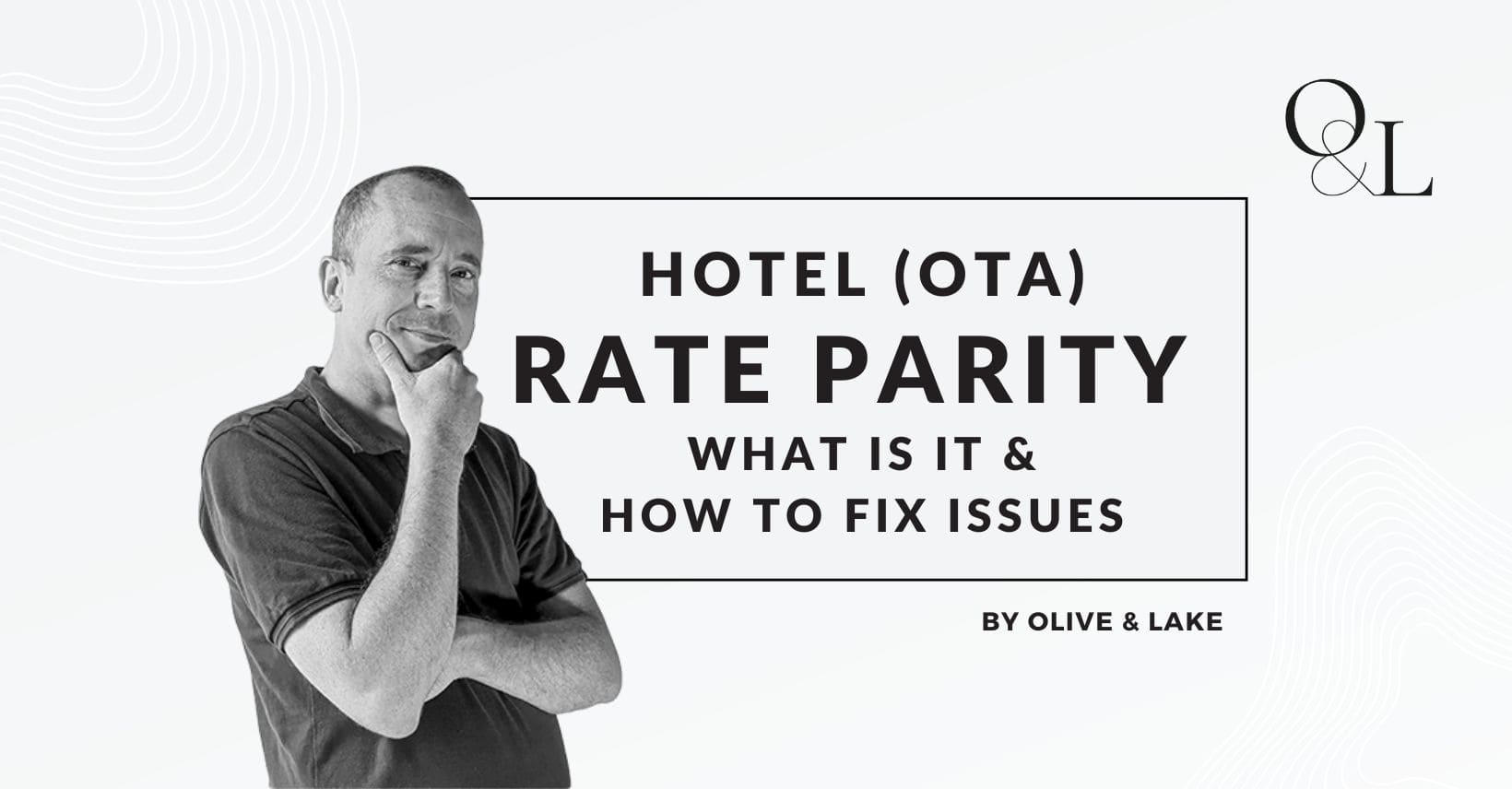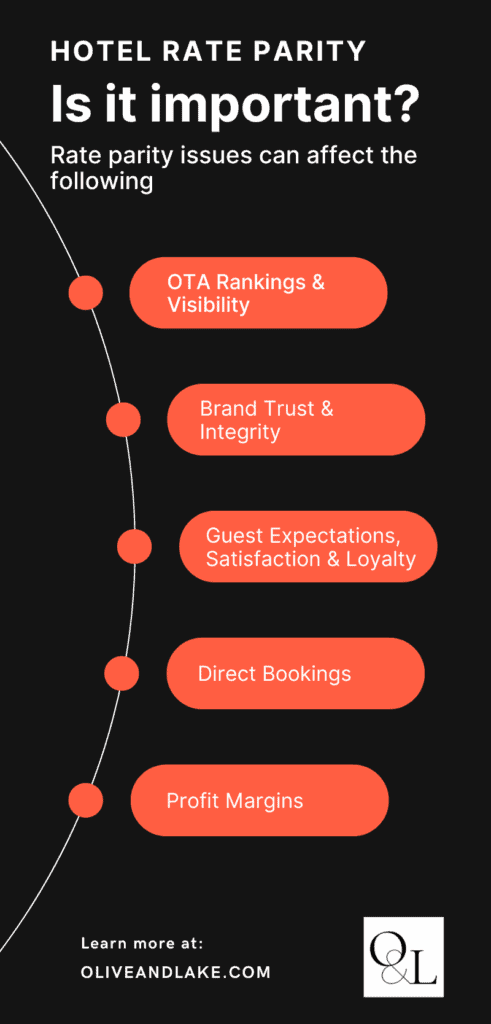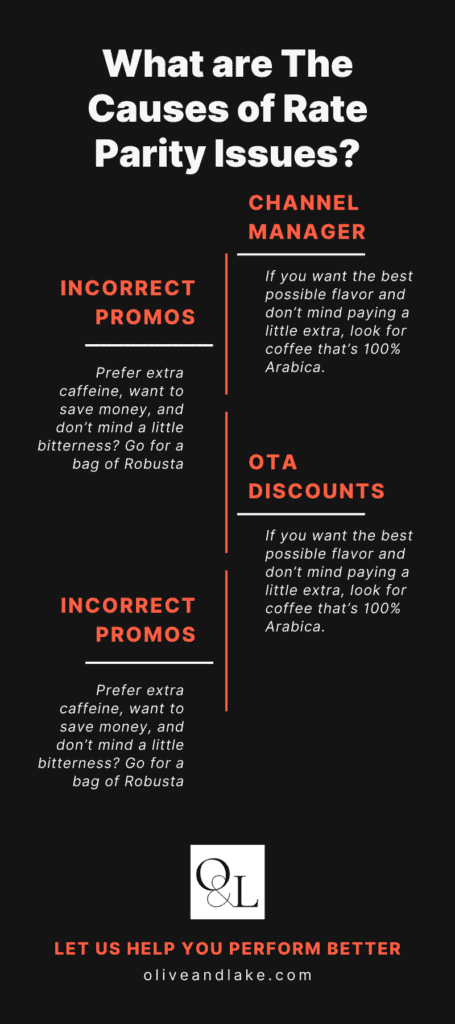In this guide for hoteliers, we’re going to take a closer at Rate Parity, what it is and how it can affect your hotel.
Olive & Lake offers services to hoteliers to help with drive more bookings and our services related to rate parity include:
If, after reading this article, you need help to manage your rate parity, please contact us and we’d be happy to discuss it with you.
What is hotel (OTA) Rate Parity?
Hotel rate parity is the practice where the same room prices are offered across all distribution channels, including online travel agencies (OTAs), website booking engine, and any other 3rd party platforms. This means that no matter where potential guests look to buy a room at your hotel, the price should be the same everywhere they look.
This is easy to understand in theory, but harder to implement and there is some discussion on whether hotels should aim for rate parity or not. We’ll get into more detail in these two topics further down in this guide.
Wide Rate Parity
The practice of ensuring that your room rates are the same across all distribution channels, including your own website, is known as wide rate parity. In places where this is implemented, the hotelier will usually agree with OTAs that they cannot offer lower prices on their own website or any other channel.

Narrow Rate Parity
There has been some backlash to wide rate parity and in some countries, it’s not only frowned upon, but also illegal[1]. Agreements in many European countries have allowed for a more lenient approach to wide rate parity including France, Italy, Austria, Germany, and the UK.
Although the US has been less aggressive than in Europe, discussions and legal actions have also led to a shift in the industry, with many OTAs and hotels adopting narrow rate parity clauses.
Narrow rate parity allows hotels to offer lower rates on their own website compared to other major booking websites.
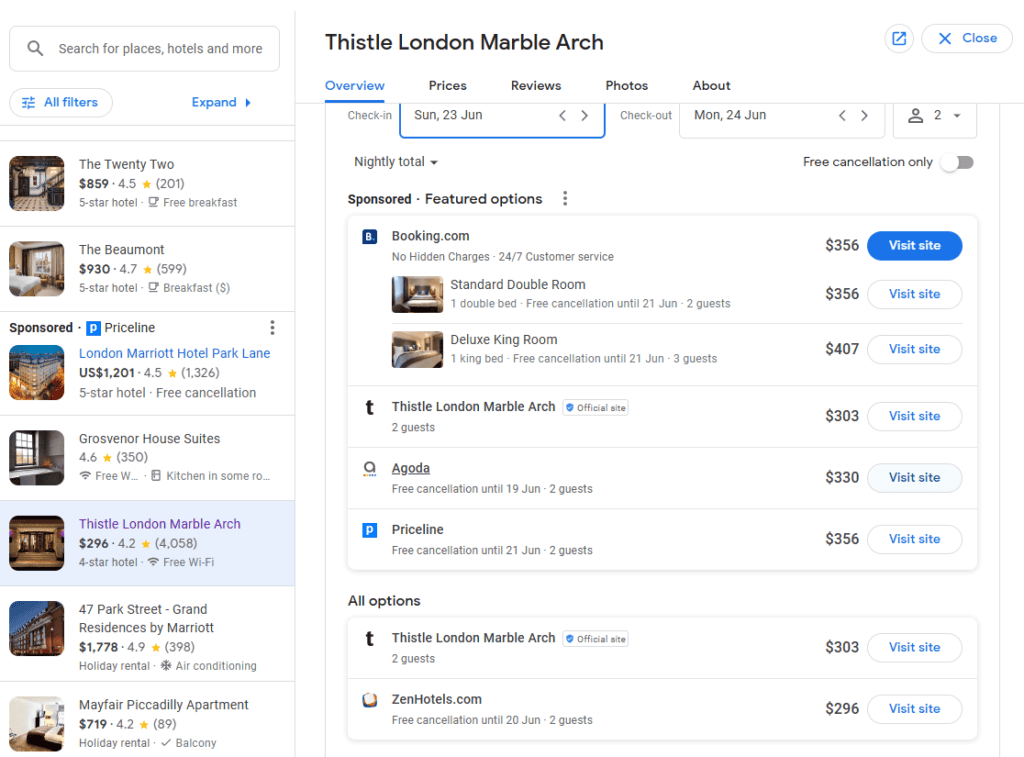
This allows hotels more freedom to set direct booking prices allowing them to be competitive and arguable give consumers more choice. The challenge here is to drive people to book by contacting you instead of getting an instant booking confirmation from your booking engine or OTA.
However, this doesn’t stop OTAs from restricting your visibility if they find that they are not getting competitive prices.
What is an example of rate parity?
As you can see from the screenshot below, the DoubleTree by Hilton London is offering the same rate to Agoda, Booking.com and their official website. At the time of checking, the rate was $178 / night across all sales channels.

As you’ll find out below in this guide, there are sometimes issues with rate parity caused by no fault of the hotel. OTAs will regularly “play” with their prices to undercut each other and take the different out of their commission. Why might you ask? I guess the only viable reason is for market share to keep their shareholders happy!
Why is Rate Parity important for hoteliers?
For some hotels, rate parity is important because it can affect the following areas:
- OTA rankings (and therefore visibility)
- Brand trust and integrity
- Guest expectations, satisfaction and loyalty
- Direct bookings
- Profit margins
- Regulatory compliance
However, it’s not the case for all hotels. In some instances, it might be preferable to have price disparity. For example, you might want to focus your distribution efforts on one OTA which sends you the most bookings or has preferable commission rates.
What are the benefits of rate parity?
On top of the factors mentioned in the previous section, ensuring rate party, as best as possible, can have many benefits for both hoteliers and consumers. Hoteliers can:
- Simplify their revenue management and distribution strategies.
- Increase direct bookings, with narrow rate parity, by offering exclusive deals and rates directly to customers. This in turn, can help reduce commission costs and increase profit margins.
Consumers can also be at an advantage:
- Transparency and fairness – consumers can benefit from a clear and consistent pricing making it easier to compare options.
- Confidence in booking – knowing that the price won’t vary significantly across different channels gives consumers confidence in making a booking decision.
- Loyalty Programs and Direct Booking Perks – hotels can offer additional benefits for booking directly which will enhance their overall value for consumers, even if the rate is the same.
For the industry in general, rate parity can help with:
- A level playing field among booking channels including OTAs and direct booking which creates a fair marketplace.
- Market stability – by preventing pricing fluctuations and undercutting, rate parity contributes to a more stable market environment, which can be beneficial for the long-term health of the hospitality industry.
Why are some hotels against rate parity?
Some hotels don’t like rate parity for several reasons including:
- Limited pricing flexibility – rate parity agreements can restrict a hotel’s ability to adjust prices freely across different channels which can be challenging in dynamic markets where quick pricing adjustments are necessary to respond to demand.
- Reduced direct bookings – wide rate parity agreements prevent hotels from offering lower rates. While they can still offer extra incentives to book direct, not being able to display these incentives in places like metasearch may result in fewer clicks to their websites to find out about such increases, therefore reducing direct bookings.
- Dependency on OTAs – While OTAs provide valuable exposure for hotels, they also charge significant commission fees. Wide rate parity agreements make it harder for hotels to drive direct bookings and build direct relationships with customers.
- Impact of Competition – critics argue that standardising prices across platforms make it harder for new or smaller hotels to compete and innovate in the market, which could potentially lead to higher prices for consumers.
- Regulatory concerns – it’s not just hotels criticising rate parity clauses, regulators in several countries have expressed concern that they violate antitrust or competition laws by restricting the free market.
- Barrier to Personalised Pricing – hotels are increasingly looking to offer personalised pricing and promotions based on customer loyalty, past behaviour, or other factors. Rate parity can limit the ability of offer such personalised deals.
Given these criticisms, some hotels and industry groups advocate for a more flexible approach to pricing and distribution, including the adoption of narrow rate parity or the elimination of parity clauses together.
What is best for your hotel?
This is a difficult question to answer because each hotel and the market they operate is different. If you are reliant on OTAs for bookings, then you might consider having rate parity so that you can maximise your visibility on multiple channels.
However, you might find that one OTA is providing you the most bookings, so you might want to give them the best rates. Having said this, an over reliance on just one OTA could be a risky strategy.
If you have more bookings from other partners, tour agencies, group bookings or direct bookings, you might want to forget about rate parity altogether.
Regardless of what rate strategy you implement, it’s up to the OTA to provide you with visibility. If you are not getting bookings on a particular platform because they have a higher rate than others, then they have no reason to promote your property.
What are Rate Parity Issues?
So, you’ve decided you’re going to use either a wide or narrow rate parity strategy, so where do you go from here? You need to ensure, as much as possible, that you are giving the same rates to all your distribution channels. However, this is often easier said than done. You’ll often find that you have rate parity issues or rate disparity.
Rate parity issues are simply that you don’t have the same rates across your distribution channels, leading to rate disparity.
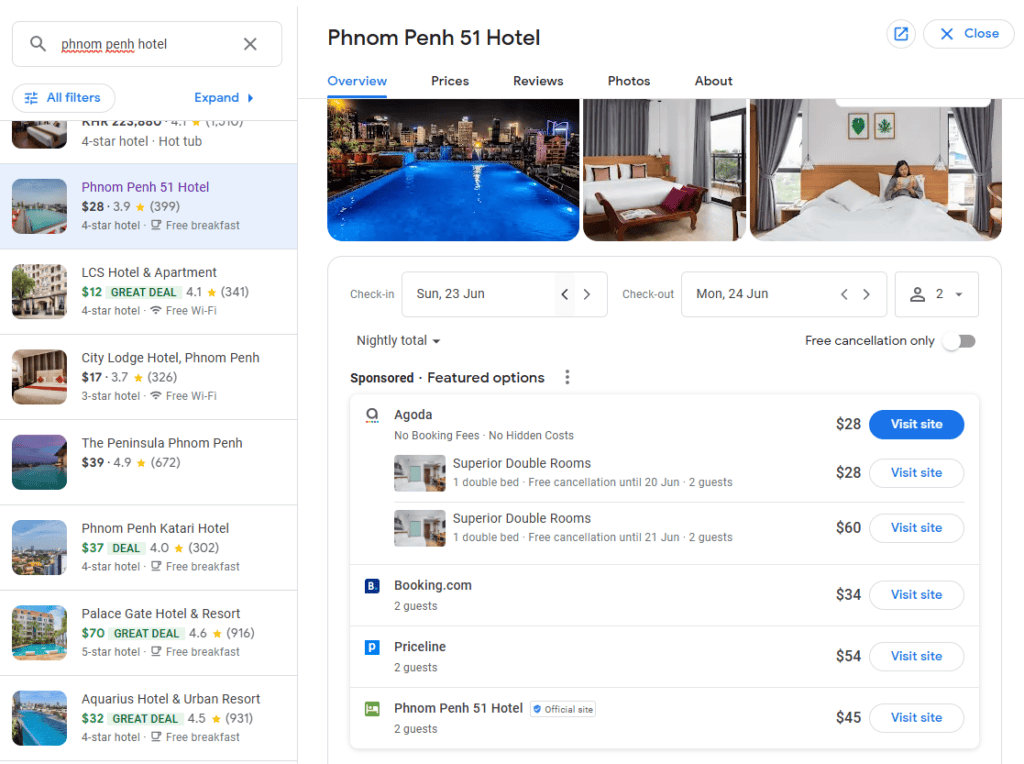
How do you fix rate parity issues?
The fist step is to identify all the channels where you are currently selling your rooms. There may be other channels which are selling your rooms indirectly. For example, they might get rates from other OTAs or some offline agencies you’ve provided prices to, might be selling your rooms online at a cheaper rate.
Very simply, you should look at who is selling your rooms and promoting them and the easiest place to find this is to do a Google Hotel search[2] for your hotel.
In the example below, we can see that Heston Hyde Hotel in London has inventory available with booking.com, Expedia, hotels.com, Priceline and more. In some cases, you might not have direct relationships with these OTAs, and they share prices between themselves, especially as many are part of the same group. Hotels.com, for example, is owned by Expedia Group and Agoda is owned by Booking.com.
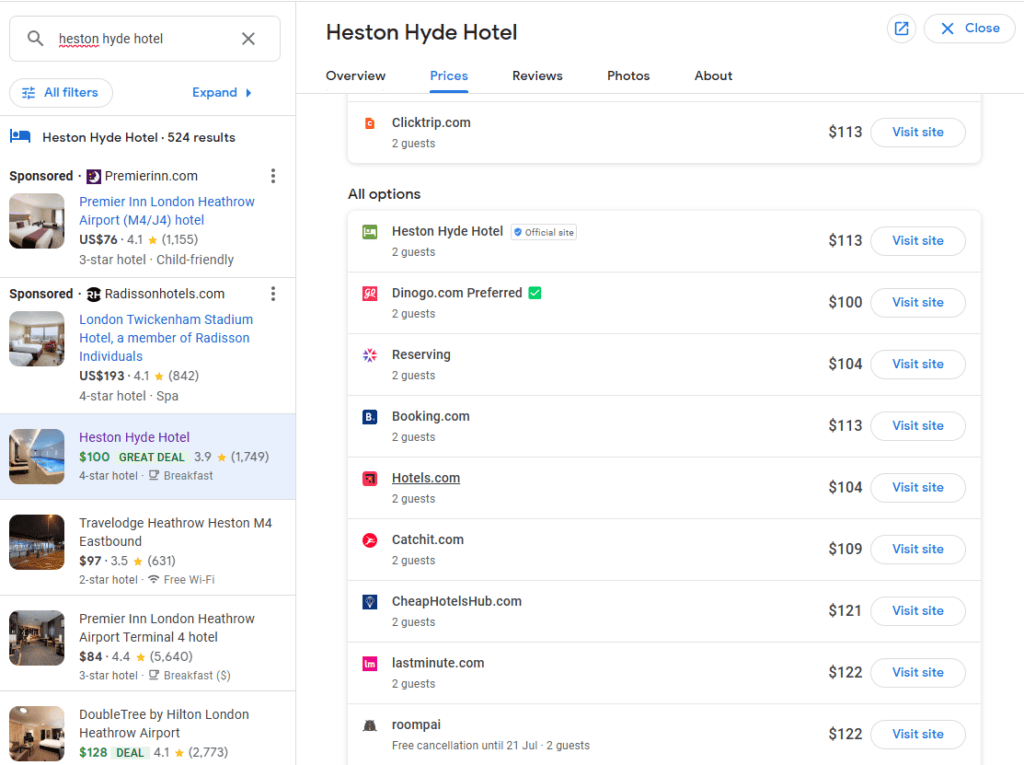
Check Rates
You can see easily from Google Hotel search the rates being offered by each channel. You can also visit your most popular OTAs, usually booking.com, Expedia and Agoda to check rates directly on their websites.
You should also check multiple dates in the future as you might find that they are correct for one given date, but on another you might have an issue.
When checking dates, make sure that you use your private or incognito browser because being logged in or cookies stored on your computer can also affect the rates you see.
Moreover, you should check from different locations. Checking rates in different countries might show different issues too.
As you can see this is quickly becoming quite a big task. To check thoroughly, it’s not just a matter of clicking a few dates on Google and noting the prices.
On top this, it’s a task that you have to perform regularly. Even if you’re doing it once a week, it’s going to be an hour or so out of your working week, just looking at prices.
Rate Parity System Hotels
Fortunately, there are many tools available to help you automate this process. Some popular ones include OTA Scanner, RateTiger, Lighthouse and RateGain. Most of these tools offer other functions such as shopping for rates from your competitors as well as your own rates.
Rate parity checkers will do an automatic scan of your online listings on all the major OTAs (booking.com, Expedia, Agoda) as well as on meta search results. It then displays this data in a table so you can easily and quickly see any rate parity issues.
Probable Causes of Rate Parity Issues
There are many causes which could lead to pricing issues, you have to go through a process of elimination to find what’s causing the problem.
Here is the list of the most common things that can cause you price parity issues:
- Channel manager and OTA connection issues
- Incorrect promotions and special offers
- OTA created discounts which they take from their commission
- B2B partners, resellers and wholesalers selling your room rates to OTAs
Channel manager & OTA connections
The first thing you need to check is if you are sending the correct rates and that these rates are being correctly received by the OTA. This will identify whether you have a connection problem.
If you’re not using a channel manager, you want to check that you have entered the rates correctly in the OTA dashboard.
You might need to contact support and ask for help if you have a technical problem. They will provide you with the solution on how to fix it.
If you’ve not found any issues with your channel manager, you now need to check the rates in the OTA’s backend.
In Booking.com you can go to the calendar view to check the rates. You need to compare the rates and inventory with what you found in your channel manager. These should be the same.
If all of this is correct, then we can move on to the next step. If you’ve found a problem here, you can reach out to booking.com and ask for advice.
You can follow the same steps for other OTAs.
Incorrect promotions and special offers
Now that we are sure that we don’t have a connection issue, we need to check that we have created consistent promotions on all sales channels.
Login to the OTA where you found the problem and check the promotion page. You might want to login to other OTAs to compare the promotions.
For example, if the problematic channel is booking.com, we would log in to booking.com extranet and then go to the Promotions page.
Check if you are running a promotion that you haven’t setup on the other channels. If this is the case, then you need to edit your promotions to be consistent.
The golden rule is consistency! If you run a promotion or join a campaign on one channel, you need to create the same promotion on the other channels! Different channels have differnt methods of creating promotions and it can sometimes be confusing.
It’s not always possible to add the same or similar campaigns across OTAs. Therefore, you should aim to run your promotions in such a way that they can be consistently duplicated across OTAs.
If you find that all your promotions are the same and everything is set up correctly, you’ll need to move to the next step.
OTA Created Discounts
Most of the time, price parity issues are caused by the OTAs themselves! When it comes to online bookings, OTAS are always seeking to improve their market share.
Sometimes, they will add a promotion to attract customers looking for the best deal. They give a discount from their own commission, so you still receive the same rate. However, this does affect your rate parity.
You will need to contact your market manager to resolve this issue for you.
To win market share OTAs are willing to cut down their margin and trigger special offers and coupons for a specific date and advertise these rates on metasearch sites to get more bookings.
The market manager will often turn off the promotion, but the chances are that in a couple of days or weeks this issue will happen again, and you will have to request that they stop their promotion once again.
One of the worst offenders for this issue is Agoda and their “Weekend Coupon” which starts on Friday and runs for the weekend. Unfortunately, market managers are unavailable at the weekend. They might also add other random discounts. All these discounts come out of their commission. Although you will still get the same money, this doesn’t your rate parity.
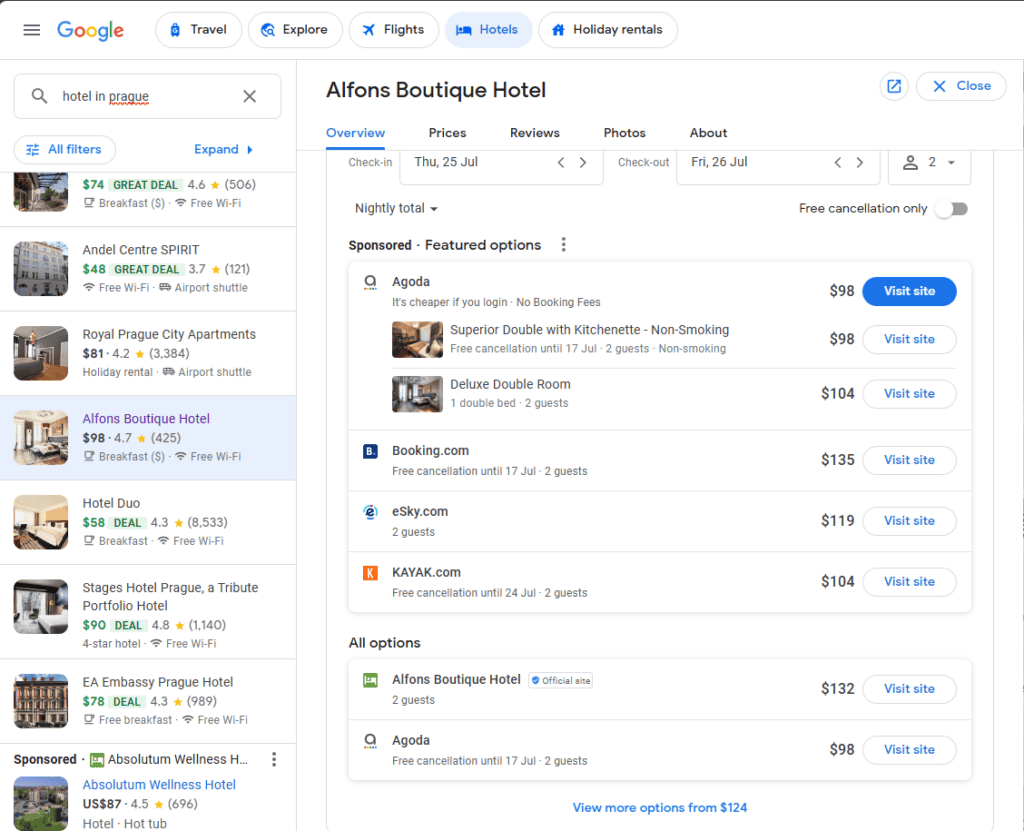
We find that the only way to stop this is to increase the rate for Agoda way above their commission rate. Therefore, the first rate they will show is a cheaper rate they have from Booking.com (their parent company) and you’ll end up with a “virtual rate parity.”
They might complain to you, but it’s almost as if they are forcing hoteliers into this decision by doing this in the first instance. If they didn’t apply the discounts, you wouldn’t need to increase the price you give them!
Although many OTAs has started to implement a strategy as mentioned above, Agoda seems to have got itself a reputation for, what some consider, deceitful behaviour.[3]
B2B partners, Resellers and Wholesalers
If you notice cheaper rates on the OTA’s live site that don’t appear in your calendar, then it could be that they got this rate from one of your B2B partners or wholesalers.
For example, you might have an agreement with a local travel agency or hotel room wholesaler at a much cheaper rate than you display publicly. This partner, then goes to Agoda and offers them a rate which is cheaper than your direct rates.
Some OTAs will display B2B rates alongside your prices on your hotel listing. Agoda and Ctrip are notorious for this problem.
This is not fair, but if you agreed to sell to another partner at a much cheaper price, you might consider include a clause in your contract which forbids them from publicly advertising a cheaper rate online.
This is the worst-case scenario and the hardest issue to solve. In some cases, it can’t be resolved, and you will need to renegotiate terms with your offline partners.
First, you need to identify which travel agent or wholesaler is selling your rooms online. You might need to reach out to your partners and ask them directly to stop.
If you can’t find out which wholesaler is providing the cheaper price, you can ask your OTA market manager. However, they often refuse to tell you.
Therefore, your last option available is to make a fake a booking yourself. Find the cheaper rate and book the room. When the booking has been processed and confirmed, you will be able to identify the source of the booking.
You will either be told in your booking confirmation email who just made the booking, or you will be contacted directly by your partner to arrange the booking. Either way, you will find out where this reservation came from.
You now have all the information needed to fix the problem from a B2B partner who is undercutting your online rates.
Hote Rate Parity
Navigating the complexities of hotel rate parity is crucial for maintaining a competitive edge in the hospitality industry. It’s about striking the right balance between ensuring consistency across all your distribution channels and leveraging strategic pricing flexibility to enhance direct bookings and guest loyalty.
As hoteliers, it’s important to stay on top of your pricing strategy, employing a robust revenue and distribution strategy and using tools to monitor and address rate disparities.
Resources
[3] Revenue Hub
